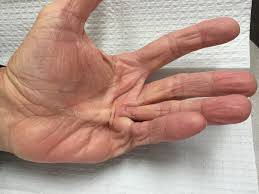Dupuytren's Contracture
Dupuytren's contracture is a hand deformity that gradually thickens and tightens the tissue under the skin of the palm. This condition primarily affects the ring and pinky fingers, causing them to bend towards the palm and limiting their movement.
---
20 Causes of Dupuytren's Contracture
1. Genetics: A family history of Dupuytren's contracture increases the likelihood of developing the condition.
2. Age: More common in people over the age of 50.
3. Gender: Men are more likely to develop the condition than women.
4. Northern European Ancestry: Individuals of Scandinavian, Irish, or Northern European descent are at higher risk.
5. Smoking: Tobacco use has been linked to the development of Dupuytren's contracture.
6. Alcoholism: Heavy alcohol consumption can increase the risk.
7. Diabetes: People with diabetes have an increased likelihood of developing this condition.
8. Epilepsy: Certain seizure medications used to treat epilepsy have been associated with Dupuytren’s.
9. Thyroid Disorders: Conditions like hypothyroidism may increase the risk.
10. Liver Disease: Chronic liver conditions can be a contributing factor.
11. Autoimmune Disorders: Conditions like rheumatoid arthritis or lupus can increase inflammation in connective tissues.
12. Hand Trauma: Repeated injury or trauma to the hand can increase the likelihood of developing the condition.
13. Occupational Stress: Jobs involving repetitive hand use or vibration tools may contribute.
14. Vascular Diseases: Poor blood circulation may be linked to tissue thickening.
15. Use of Certain Medications: Long-term use of medications that affect blood flow or tissue health can contribute.
16. Smoking: Reduces blood flow and can lead to tissue changes over time.
17. Increased Collagen Production: The body may produce too much collagen, causing tissue thickening.
18. Connective Tissue Disorders: Conditions that affect the health of connective tissues may increase risk.
19. Chronic Inflammation: Long-term inflammation in the hand’s tissue can cause thickening over time.
20. Metabolic Syndrome: A cluster of conditions like high blood pressure, high blood sugar, and obesity may contribute to the development of Dupuytren’s contracture.
---
20 Signs and Symptoms of Dupuytren's Contracture
1. Nodules in the Palm: Small lumps under the skin of the palm that may feel tender.
2. Thickened Skin: Skin in the palm becomes thicker or tighter.
3. Finger Flexion: One or more fingers bend towards the palm.
4. Limited Finger Movement: Difficulty fully extending the fingers, particularly the ring and pinky fingers.
5. Finger Stiffness: Fingers feel stiff, especially in the morning.
6. Visible Cords Under the Skin: Thickened bands of tissue running along the palm.
7. Finger Deformity: Progressive curling of the fingers toward the palm.
8. Dimpling in the Palm: Pitted areas or dimpling in the skin of the palm.
9. Lack of Pain: Dupuytren's often progresses without pain, even as it causes finger contraction.
10. Slow Progression: The condition develops gradually over months or years.
11. Inability to Place Hand Flat: Difficulty placing the affected hand flat on a surface.
12. Finger Contracture: The fingers become permanently bent and cannot be straightened.
13. Difficulty Gripping Objects: Reduced ability to hold or grasp items.
14. Loss of Dexterity: Fine motor skills may decline due to limited finger movement.
15. Tightness in the Palm: The palm feels unusually tight, restricting movement.
16. Curling of Fingers Toward the Palm: As the condition progresses, fingers become permanently curled.
17. Swelling in the Palm: Mild swelling may occur in the affected area.
18. Pain in Advanced Stages: While early stages are painless, severe contraction can cause discomfort.
19. Deformity of Both Hands: The condition often affects both hands over time.
20. Numbness in the Fingers: Rarely, but in some cases, numbness or tingling may be present.
---
10 Effects of Dupuytren's Contracture
1. Loss of Hand Function: The affected hand may become less functional, making daily tasks difficult.
2. Impaired Grasp: Difficulty holding objects, leading to issues with grip strength.
3. Inability to Perform Fine Motor Tasks: Tasks like buttoning clothes or writing become challenging.
4. Chronic Hand Stiffness: Persistent stiffness limits the flexibility and usability of the hand.
5. Limited Occupational Capacity: Inability to work in jobs requiring fine hand movements or gripping.
6. Increased Dependency: Individuals may require assistance with activities like dressing or eating.
7. Social Isolation: Reduced participation in hobbies or social activities due to limited hand function.
8. Psychological Stress: Frustration, anxiety, or depression may develop due to loss of hand function.
9. Permanent Finger Deformity: Without treatment, fingers may remain permanently bent.
10. Surgical Intervention: Severe cases may require surgery, leading to a prolonged recovery period.
---
Prevention of Dupuytren's Contracture
1. Avoid Smoking: Smoking cessation can improve blood flow and reduce the risk of connective tissue disorders.
2. Limit Alcohol Consumption: Reducing alcohol intake may lower the risk of developing the condition.
3. Manage Diabetes: Keeping blood sugar levels in check can reduce the risk of Dupuytren’s.
4. Stretching Exercises: Regular hand and finger stretching may help maintain flexibility in the palm.
5. Avoid Repetitive Hand Stress: Minimize activities that involve repetitive gripping or pressure on the hands.
6. Use Proper Ergonomics: Ensure proper hand positioning while working to reduce strain on the palm.
7. Monitor for Early Signs: If you have a family history of Dupuytren’s, pay attention to any early signs of hand changes.
8. Manage Inflammatory Conditions: Treat autoimmune or inflammatory diseases to reduce the risk of tissue changes.
9. Stay Active: Engage in activities that keep the hands flexible and promote good circulation.
10. Seek Early Treatment: Early intervention, such as injections or physical therapy, may slow the progression of the condition.
By recognizing early signs, making lifestyle adjustments, and seeking appropriate treatment, Dupuytren’s contracture can be managed to minimize its impact on hand function.


